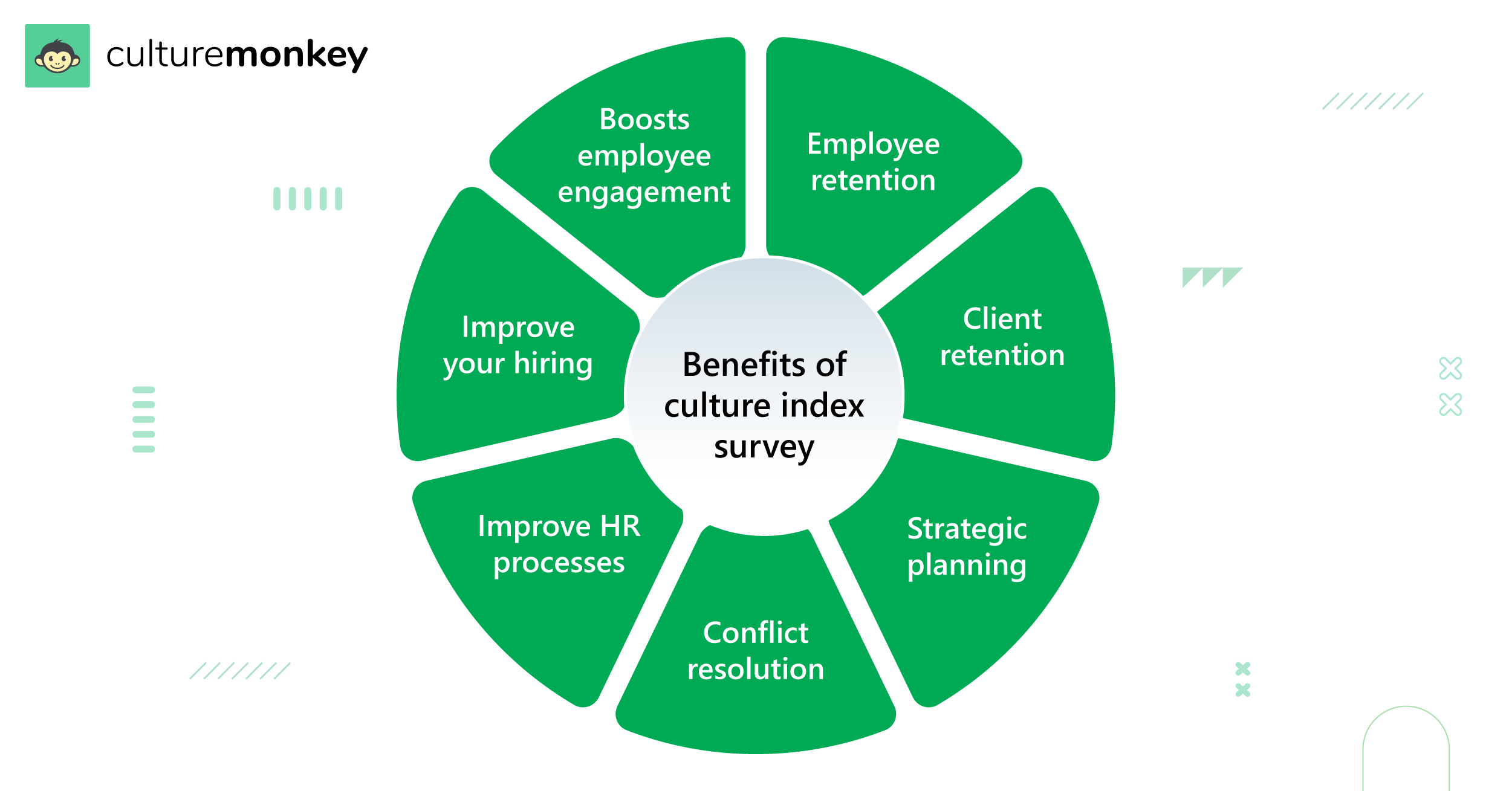25+ Culture index survey questions that you should ask your employees in 2023

Let's get into the topic straight; what do you think will make your organization a great place to work for? What will make your organization a dream company for employees to work for? How will the best talents in the market make a beeline for your organization?
How can your employee stay longer, be more loyal, and have excellent workforce productivity?
The answer is—Workplace Culture!
The workplace culture defines your organization's value, and as per Gallup, having a strong workplace culture attracts top talents, leading to 33% higher revenue.
As per Team Stage, workplace culture is essential for 46% of job seekers.
So for you to attract top talent, one must have a great company culture that gives emphasis to employee satisfaction and wellness. But how will you do it?
As a people leader, you know how hard it is for employees to express themselves freely, and at the same time how difficult it is to measure what they are feeling or what they lack at expressing.
But what if we tell you, irrespective of your organization's scale, you can analyze how your employees feel with the culture index mechanism. Stay tuned, let’s cover just that for you in this article.
Table of contents:
- What is a culture index?
- Why is the culture index important?
- What is a culture index survey?
- What is a culture index test?
- What are the culture index categories?
- What are culture index personality types?
- Key features of the culture index survey
- How to decide between the culture index and another assessment?
- Benefits of culture index survey
- How to execute a culture index survey?
- Culture index survey traits explained
- How to make use of culture index survey questions?
- How to make use of cultural index survey results?
- 10 Statistics that you should know about company culture
- Culture index survey questions for employees
- FAQs
What is a culture index?

A culture index represents how your employees feel about the workplace, including their opinions, sentiments, emotions, and attitude about the various attributes of their roles and responsibilities.
An organization has employees at different levels; typically, managers- to strategize the complete production and job performance of their respective teams, to maintain the workplace and to help their team to have a smooth functioning.
But, as a manager, it is essential to also measure your employees' feelings about their team culture in regular intervals.
This is where a culture index survey steps in and helps you to reach every perception to know what your employees experience and helps you understand what influences their work culture, beliefs, employee relations, and belongingness.
After factor analysis the things that influencing the workforce, the culture index test surveys helps you illustrate how your employees feel about being a part of your organization and further gives you insight into what can be improved in your existing company culture framework.
According to PWC Publications, 67% of employers feel that company culture is more important than operations or strategy, so even if one of the resources fails, there are high chances of the organization not fulfilling its goal.
The various culture index categories help one maintain the company culture and smooth functioning of all the resources to compete in the market.
Not only that, the culture index helps you identify the actual pain points your employees are facing throughout their life cycle with you and further lets you take actions to the problems raised; for example, whether the lack of workforce engagement due to zero encouragement or feedback from their managers.
Why is the culture index important?

A study from Lorman states that happier employees are 12% more productive and efficient than others.
Imagine there are organizations—A and B. Where organization A does not have many problems as far as their work environment is considered, their employees enjoy coming to the workplace, and all the teams are extremely proactive in completing their job responsibilities and have a proper employee feedback system in place.
Now, organization B faces all the issues with high employee turnover (more than 10%) and low workplace engagement, with a lot of employee burnout issues and has a very top-down approach when it comes to setting up employee policies.
Organizations A stands out because they value their top talents, focus on enhancing employee engagement, and make sure their employees are happier at the workplace.
On the contrary, organization B has all these engagement issues, since there is no mechanism to listen to their employees.
This is why having a feedback mechanism in the form of a culture index, comes into play.
Culture Index should be more or less considered to be the north star metric for any organization, when they are aspiring to improve their company culture.
The measuring of the cultural index score in your organization will enable you to dentify gaps in employee retention, learning and development etc. and makes all the difference for the growth of the organization.
An organization with a good culture experiences high employee engagement, employee loyalty, lower employee turnover, and attracts top talents.
What is a culture index survey?

Employees having different perceptions about the organization, management and their bosses is very natural.
If you analyze things deeply, an employees' perceptions will mostly be according to the company's culture, employee relations, organization's values, and company policies they are subjected to.
If not for the cultural index survey program, knowing how employees feel about the organization would be more of a deception.
The culture index test surveys displays how the employees feel about the organization they work for and the key factors that influence them in the workplace.
These kinds of surveys include questions that could try to understand their sentiments, opinion, and attitude toward all the elements that impact their roles and responsibilities.
So, the culture index reviews and helps employees' performance and enables them to advance at work by identifying their feelings about their organization.
Implementing an effective culture index survey will provide you with the knowledge of how to help your employees according to their individual requirements.
With the collected data, the cultural index survey helps the HR managers and leaders on how to process the employees with the informed decision.
What is a culture index test?

Well, think of it as a key that unlocks the secrets of your organization's DNA, revealing its inner workings, values, and vibes. In the ever-evolving landscape of workplaces, understanding your company's culture isn't just a "nice to have" it's a strategic imperative.
Imagine it like this: a culture index test is like a magnifying glass that lets you peer into the heart of your organization. It's a methodical process designed to gauge how your employees feel about their workplace, their roles, and the overall vibe that resonates within your company's walls (or virtual spaces in this digital age).
It's not just about the perks and paychecks, though they matter too. It's about the intangible stuff – the shared beliefs, the unspoken norms, the way your employees connect and collaborate.
But how does this test actually work? Well, it's a series of thoughtfully crafted questions that dig deep into the nooks and crannies of your company's culture. These questions touch on everything from how proud your employees are to be part of your organization, to whether they feel treated fairly, valued, and equipped to do their best work.
It's more than just a questionnaire; it's a journey of self-discovery for your company. The responses aren't just numbers; they're insights into the collective mind of your workforce. They show you where you're excelling and where there might be room for improvement.
And here's the kicker – a well-executed culture index test isn't just a one-off event. It's a periodic check-in, a way to track how your culture evolves over time, especially as your organization grows and transforms.
So, what's the payoff? A culture index test arms you with the knowledge to shape your organization into a place where people thrive, feel empowered, and actually want to show up every day.
It's like cultivating a garden – you don't just plant the seeds and forget about them. You nurture and tend to them, ensuring they grow into something beautiful and sustainable. In the same way, a culture index test helps you nurture a workplace that's not only productive but also a source of pride for everyone involved.
What are the culture index categories?

Think of them as the distinct flavors that make up the recipe of your organization's culture. Just like a dish can be a blend of sweet, savory, and a hint of spice, your company's culture is a mix of various elements that create its unique taste.
Here's the scoop on these categories:
Leadership style: It all starts at the top, doesn't it? This category delves into how your leadership team operates. Are they more hands-on, nurturing, or more focused on autonomy? This aspect shapes how decisions are made, how teams collaborate, and the overall tone of the workplace.
Communication dynamics: Ah, the power of words! This category explores how information flows within your organization. Is it a top-down approach, or does every voice get a chance to be heard? Clear, open communication can foster trust and transparency, while the lack of it can lead to confusion and frustration.
Team collaboration: How do your teams play together in the sandbox? Are they siloed, or do they seamlessly collaborate across departments? This category gets to the heart of how cross-functional projects and ideas come to life.
Employee development: Every employee is on their unique journey. This category shines a light on how your organization supports professional growth. Is there ample training, mentorship, and room to learn and climb the career ladder?
Work-life balance: Burnout or balance? This category delves into whether your organization encourages a healthy separation between work and personal life. A culture that values well-being can lead to happier, more engaged employees.
Diversity and inclusion: Does your organization embrace the kaleidoscope of perspectives and backgrounds? This category examines how diverse your workforce is and whether inclusion is woven into the fabric of your culture.
Innovation culture: Does your workplace nurture innovation and experimentation? This category helps you understand if employees are encouraged to think outside the box and contribute fresh ideas.
Recognition and rewards: High-fives for a job well done! This category explores how your organization acknowledges and rewards exceptional performance. Recognition can be a powerful motivator for employees.
Adaptability: In the whirlwind of change, how does your organization fare? This category gauges how agile and adaptable your culture is in the face of shifts and challenges.
Each of these categories adds a layer to your organization's culture quilt. They're interconnected, and together, they shape the overall employee experience.
What are culture index personality types?

Picture a movie with an ensemble of personalities, each contributing their unique flair to the narrative of your workplace.
- The drivers: These are the trailblazers who don't just follow the path – they forge it. Drivers are assertive, goal-oriented, and thrive on challenges. They're your natural-born leaders, charging forward with determination and vision.
- The analysts: Precision is their middle name. analysts have a keen eye for details and a knack for analyzing data. They bring logic and structure to the table, making them your go-to folks when intricate problem-solving is needed.
- The collaborators: It takes a village, and the collaborators are the ones who bring everyone together. They excel at teamwork, communication, and building relationships. Their ability to foster camaraderie and bridge gaps makes them indispensable connectors.
- The diplomats: Imagine a world where conflicts are resolved with finesse and empathy – that's where the diplomats shine. They're the peacemakers, skilled at diffusing tensions and ensuring harmonious interactions. Their emotional intelligence is a soothing balm in a world of differences.
- The performers: Lights, camera, action – the performers thrive in the spotlight. They're your creative souls, injecting enthusiasm and energy into every endeavor. Their charisma is infectious, making them natural motivators and influencers.
- The facilitators: Behind every smooth operation is a facilitator. They're the organizers, ensuring that processes run seamlessly. With a knack for managing resources and schedules, they keep the gears of your organization well-oiled.
- The conservers: Change may be constant, but conservers prefer stability. They value tradition, reliability, and consistency. Their steady approach ensures that your organization's foundations remain strong.
- The achievers: The name says it all – Achievers set their sights on success and won't settle for less. They're ambitious, determined, and motivated to achieve their goals. Their drive can be contagious, inspiring others to reach for the stars.
- The craftsmen: Precision meets creativity in the craftsmen. They're the ones who take pride in their workmanship, paying attention to every detail. Their dedication to quality ensures that excellence becomes the standard.
- The visionaries: Big dreams and even bigger ideas – that's where the visionaries thrive. They're innovators, always thinking ahead and imagining new possibilities. Their foresight can guide your organization toward exciting horizons.
Each personality type brings a unique ingredient to the culture recipe. Just like a symphony, the harmony of these diverse personalities creates a rich and vibrant workplace culture.
Key features of the culture index survey
The culture index survey traits consist of multiple key components that make it stand out from similar assessments. Let’ see why we you need to send culture surveys to your employees and analyze some of its key features here:
- The survey data collected through the cultural index survey results are useful in many stages of the employee life cycle, including recruiting, developing, and employee engagement as it helps you uncover hidden insights about your employee’s engagement issues and the data acts as a tool for you to check on employees
- The questions in the cultural index survey are simple and easy to understand for the employees to provide their feedback. Also, the survey metrics derived from the feedback are easy to comprehend and actionable for a people leader
- The survey results gathered opens the gate to a wide range of data from employees. A large quantity of data helps you analyze the workplace culture, patterns, and other key insights for further development
- These surveys help you measure the pulse of your employees, understand their concerns accurately and solve their culture and workplace problems accurately measuring the right metrics and key drivers of employee engagement.
- The survey metrics derived from the feedback are easy to comprehend and actionable for a people leader. But what makes these insights truly valuable is their direct link to actionable steps. The survey doesn't just provide a sea of data; it guides leaders toward clear and effective actions.
- While many surveys offer a one-size-fits-all approach, the culture index survey recognizes that every organization is unique. It allows for customization to suit your specific context.
- A standout feature of the culture index survey is its capacity for longitudinal analysis. It doesn't just provide a snapshot of your organization's culture; it allows you to track changes over time. This is essential for evaluating the effectiveness of your interventions and strategies.
- More than just a data collection tool, the culture index survey fosters dialogue within your organization. It opens channels of communication between leaders and employees, allowing for open discussions about culture, values, and aspirations.
How to decide between the culture index and another assessment?

So, how do you decide between the Culture Index and another assessment? It's like choosing the perfect tool for a specific job – you want the one that fits just right. Here's the lowdown to help you make the call.
Consider your objectives
What are you aiming to achieve? The Culture Index might be your best bet if you're diving deep into your organization's cultural nuances. It's tailored to understanding the intricate threads that weave your workplace culture.
On the other hand, if you're looking for a broad snapshot of employee satisfaction or engagement, a more general assessment might do the trick.
Scope and depth
The Culture Index is like an archaeologist's brush, delicately uncovering hidden gems. It digs deep into specific culture-related aspects. If you're seeking insights into broader areas like employee performance or customer feedback, another assessment might offer a more holistic view.
Alignment with goals
What do you want to achieve through this assessment? If your goal is to align your culture with your business strategy, the Culture Index aligns like stars in a constellation. But if you're after something more specific, like identifying skill gaps or evaluating training needs, other assessments might suit your purpose.
Employee feedback
Your employees' voices matter. Consider their preferences and comfort levels with the assessment format. The Culture Index involves employee feedback, which can be incredibly insightful, but if your team responds better to a different type of assessment, that's a crucial factor to weigh.
Timing and frequency
Are you in for the long haul or a quick check-in? The Culture Index is great for periodic evaluations and tracking culture evolution. If you're looking for rapid, real-time feedback, another assessment might provide quicker results.
Customization
One size doesn't fit all. If you need a tool that's customizable to your organization's unique quirks, the Culture Index's tailored approach could be your cup of tea. But if you're aiming for a standardized, benchmarked assessment, other options might suit you better.
Benefits of culture index survey

Having culture index surveys as a part of your workplace engagement strategy can go a long way, as it would help you understand various aspects of your organization's employee engagement state and further improve it.
Here are the top 7 benefits of running a culture survey for your organization:
1. Employee retention through culture index test
An organization with an attractive workplace culture has higher employee retention and a workspace where the employees have to be enthusiastic to provide better performance.
The U.S. Bureau of Labor Statistics states there was around 47.2% of employee turnover in 2021 (including various industries).
Thus, the culture index survey can help you predict attrition, give you insights on why your employees feel like leaving the organization and will further help analyze your organization's happiness levels to push employees beyond the organization's goals.
2. Customer retention through employee engagement
Happy employees bring in happier clients, and only a happy customer will keep returning to your business. Thus, employee happiness is an essential part of client retention for your business.
As per Annex Cloud, the probability of making deals with an existing client or customer is 60% to 70%, while approaching a new client is 5% to 20%.
So acquiring new customers is expensive and requires a lot of time and resources, but a culture index survey indirectly helps you retain your clients along with employee engagement.
3. Strategic planning for company culture
Strategic planning is a crucial part of any company's success. Implementing strategic planning is only possible when your people leaders are in sync with your employees thoughts, expectations and their mindset.
As per ClearPoint Strategy's statistics, 80% of leaders say that their company is good at crafting, but only 44% feel that they are good at implementing.
So, using a culture index survey you can understand the climate of your organization, encourage employees to be more proactive in voicing out their honest feedback and help you frame relevant employee policies.
4. Conflict resolution within organization
Any conflict in an organization requires immediate resolution for the smooth functioning of the business.
According to the Center for Management & Organization Effectiveness (COME), 49% of workplace conflicts are due to clashes between personalities and ego.
Thus, a people leader needs to understand the reason for uneasiness amongst the employees by constantly listening to them through culture index surveys and should take actions to nip them in the bud, so that the issue doesn’t lead to a big conflict within the employees or with the management.
5. Improve HR processes
Identifying the gaps in your company’s employee policies and working on them would help to improve the overall organization's process of managing employees from pre-boarding to off-boarding stage.
Reducing the human resource department's workload in knowing what employees feel about their company through the culture index survey can lead to more involvement in onboarding, training, performance appraisal, etc.
A culture index will help you figure out the blind spots in your current company culture policies and would help you improve your procedure accordingly.
6. Improve your hiring
Most companies fail to improve their hiring practices, and still have a very age-old employee hiring process in place, which doesn’t give much importance to diversity, equity & inclusion, preference to remote work etc.
To compete in the market of passive talents, you should focus on enhancing the brand's reputation by being inclusive and updated in your hiring practices.
Per CareerArc, 89% of job seekers evaluate employers with their brand's reputation even before applying for the position.
The use of culture index surveys could help you identify the latest trends and requirements for a fresh candidate you hire, so that you could pick the perfectly suited candidate for the proper role and reduce attrition in your organization.
7. Boosts employee engagement
Casual or fun Fridays can’t be your organization's only employee and workplace engagement strategy to cater to their work-life balance needs, especially after the post-pandemic hybrid work era.
Remember, engaged employees will push themselves beyond expectations, maintain employee morale, positive relationships with fellow employees, and be happy to assist new employees in their training.
According to Gallup, Globally, as low as 20% of the employees are actively engaged in their workplace.
So, it's essential for people leaders to be more open to listen to your employee's opinions and ideas, and use the culture index survey to understand what your employees feel.
8. Enhanced decision making
Culture index surveys provide you with data-driven insights that can significantly impact your decision-making processes.
The collected feedback helps you understand employee sentiments, preferences, and pain points. Armed with this information, you can make informed decisions about organizational changes, new initiatives, and policy implementations.
This ensures that your strategies align with your workforce's needs and expectations, increasing the chances of successful outcomes.
9. Fostering innovation
A positive company culture is closely linked to innovation and creativity. When employees feel comfortable expressing their ideas and opinions, they're more likely to contribute innovative solutions.
Culture index surveys allow employees to share their suggestions, thoughts, and creative insights.
By nurturing this environment of open communication, you're fostering innovation from the ground up, potentially leading to breakthrough ideas that can drive your organization forward.
10. Enhanced team collaboration
Effective collaboration among teams is essential for achieving business goals. Culture index surveys can reveal collaboration challenges or opportunities within your organization.
You can identify departments or individuals that might need additional support or resources to collaborate more seamlessly.
By addressing these areas, you can create a more cohesive and productive work environment, where teams work harmoniously towards common objectives.
11. Personalized employee development
Every employee is unique, with their own strengths, weaknesses, and career aspirations. A culture index survey can help personalize employee development plans.
By understanding employees' goals and preferences, you can tailor training programs, mentorship opportunities, and growth paths to match their individual needs.
This not only boosts engagement but also contributes to a workforce that's equipped with the skills and knowledge needed to excel.
How to execute a culture index survey?
Just like everybody else, the perceptions of employees will keep changing over time, so companies have to conduct regular culture index surveys to attain higher employee engagement, staff retention, productivity, and culture.
But make sure you have an excellent structural design before implementing the culture survey to have blueprints of every survey stage.
Deploy surveys
Make sure you define your focus on the culture index survey, so it will help you frame the questions appropriately. Send them to the relevant department or the employees you want to involve as part of your survey.
Gather response
Conducting a survey is just a preliminary step of the culture index. After the survey, you will have loads of data to analyze and re-examine your current working process to revamp for launching new.
Data analysis
Analyze the recent trends over the gathered survey data to learn what will and will not for your organization. Calculate the employee net promoter score to know more about your employees' loyalty and whether they will recommend your company as a great place to work for, to the outsiders.
Action plan
Develop a suitable action plan using the culture index survey results to identify and fill the gaps in your company's process. Keep using the results to improve your systems actively and to show your employees that you care for them in every way.
Employee involvement
Involve employees in the action planning phase that follows the survey analysis. Form cross-functional teams to brainstorm and implement solutions based on the survey insights. This empowers employees to contribute to positive change and fosters a sense of ownership and engagement.
Long-term culture evolution
Understand that transforming your organization's culture is a journey that requires consistent effort. Use the culture index survey as a periodic touchpoint to assess progress and identify new areas for enhancement. Track key metrics over time to measure the impact of your interventions.
Leadership alignment and commitment
Ensure that leaders are aligned with the purpose and goals of the culture index survey. Their commitment is essential for its success and for creating an environment where employees feel valued and heard. Encourage leaders to actively participate in the survey, share their perspectives, and champion the changes that result from it.
Culture index survey traits explained

These are the threads that weave together to create a comprehensive picture of your organization's culture. Imagine them as the constellations that map out the unique galaxy of your workplace.
- Cultural alignment: This trait delves into how well your employees resonate with your organisation's core values and mission. Are they sailing in the same direction, driven by shared beliefs? Cultural alignment is like the magnetic force that keeps everyone moving toward a common purpose.
- Employee engagement: Ever heard the phrase "happy employees, happy workplace"? That's where this trait comes into play. It measures how connected and committed your employees are to their roles, teams, and the organization as a whole. High engagement levels can fuel productivity and innovation.
- Leadership dynamics: This trait puts the spotlight on your leadership team. Are they inspiring, communicative, and approachable? It scrutinizes how well your leaders resonate with their teams, fostering a culture of trust and respect from the top down.
- Communication style: Effective communication is the glue that binds a team. This trait explores how information flows within your organization. Are channels open, transparent, and inclusive? A healthy communication style can prevent misunderstandings and nurture collaboration.
- Collaboration culture: Teamwork makes the dream work, right? This trait delves into how well your employees collaborate across departments. Do they share ideas freely, support one another, and work synergistically? A strong collaboration culture can drive creativity and problem-solving.
- Innovation mindset: Innovation isn't just about gadgets but fresh ideas and novel approaches. This trait evaluates whether employees are encouraged to think creatively, challenge the status quo, and contribute to positive change.
- Adaptability quotient: In a world of constant change, adaptability is key. This trait examines how well your organization navigates shifts, whether it's embracing new technologies or adapting to market trends. A high adaptability quotient ensures your organization doesn't just survive but thrives.
- Diversity & inclusion outlook: Diversity isn't just about numbers; it's about creating an inclusive space where everyone's voice matters. This trait measures how diverse your workforce is and how actively your organization promotes equity and inclusion.
- Recognition and rewards approach: Acknowledgment is a powerful motivator. This trait explores how well your organization recognizes and rewards exceptional performance. A thoughtful approach to recognition can boost morale and foster a culture of appreciation.
- Learning and development embrace: Lifelong learning is the heartbeat of growth. This trait assesses how well your organization supports employee development, whether it's through training programs, mentorship, or learning opportunities.
How to make use of culture index survey questions?
Now that you know the nitties and gritties of the culture index survey, let’s jump into how we can get into action with the culture survey questions.
The employee feedback survey collected through the culture index survey helps you find better ways to support your employees and improve your organization's workplace culture.
A feedback survey can help identify areas where the employee needs help and what steps you can take to improve the company culture. The online survey tools provide concentrated suggestions for the management to work on workplace engagement, but make your surveys anonymous for maximum impact.
How to make use of cultural index survey results?

- Data interpretation: Survey results are like puzzle pieces; you need to put them together to see the bigger picture. Dive into the data and identify trends, patterns, and outliers. What do the numbers and responses reveal about your organization's culture?
- Identify strengths: Every organization has its shining moments. The survey might highlight areas where your culture is already thriving. Identify these strengths and celebrate them; they're the foundation on which you can build even greater success.
- Pinpoint opportunities: Ah, the sweet spot where growth awaits. The survey might unveil areas that need improvement or enhancement. These are your growth opportunities – the places where a little TLC can make a significant impact.
- Employee feedback loop: Remember, the survey isn't just about data; it's about the voices behind the numbers. Share the survey results transparently with your employees. This not only validates their input but also fosters a culture of open communication and trust.
- Actionable insights: Turn insights into actions. For each identified opportunity, brainstorm strategies that can drive positive change. Whether it's enhancing leadership training, promoting diversity initiatives, or revamping communication channels, make your insights actionable.
- Prioritize with purpose: While you might want to tackle everything at once, focus is key. Prioritize based on the potential impact and feasibility. What changes can create a ripple effect throughout the organization?
- Cross-functional collaboration: Transforming culture requires a village effort. Collaborate across departments and levels to implement changes effectively. Get buy-in from leadership and involve employees who are passionate about driving change.
- Set clear goals: Just like any project, set clear goals for each change initiative. What do you want to achieve? Whether it's increased employee engagement or improved communication, having a target guides your efforts.
- Measure and adjust: The journey doesn't end with implementation. Continuously measure the impact of your initiatives. Are engagement levels rising? Is communication improving? If needed, be ready to adjust your strategies based on feedback.
- Celebrate progress: Culture transformation is a marathon, not a sprint. Celebrate even the smallest wins along the way. Recognition and celebration reinforce the positive changes you're making.
10 Statistics that you should know about company culture

- Deloitte reveals that 94% of executives and 88% of employees recognize the significance of a distinct workplace culture for achieving business success.
- According to Forbes, 76% of employees understand the correlation between a well-defined business strategy and nurturing a positive work culture.
- Randstad US highlights that 36% of employees have contemplated leaving their jobs because remote work options were unavailable.
- Robert Half Media Room's data suggests that 65% of employees aged 55 or older are more inclined to accept a job offer if it includes telecommuting opportunities.
- As indicated by Lexington Law, 38% of U.S. employees aspire to have a job that aligns with their personal interests and passions.
- Udemy's research uncovers that 42% of millennial employees prioritize learning and development opportunities when evaluating job prospects.
- Randstad's findings indicate that 63% of employees would dismiss a job offer if the company provided fewer than 15 days of paid time off per year.
- Jobvite's survey underscores that 46% of candidates consider culture a highly important factor during the application process, with 88% acknowledging its relevance.
- As highlighted by Robert Half Media Room, 35% of American workers will decline the "perfect" job if they perceive the company culture as incongruent.Lexington Law's insights reveal that 60% of U.S. employees would opt for a job they love, even if it pays half their current salary, over a higher-paying job they dislike.
Culture index survey questions for employees
With this, you would have known how crucial it is to conduct culture index surveys frequently for your employees.
But again, you can't set up random tools or questions for your employees, as asking irrelevant questions will lead you nowhere, and not addressing your employees' specific needs shows your lack of interest in employees' workplace engagement.
So, as a people leader, you should understand how to adapt to technology and leverage it to lead your employees to effective culture index and engagement goals.
Here is where CultureMonkey's customizable and personalized engagement survey comes in handy just for you.
CultureMonkey's Culture Index Survey is flexible enough for you to customize questions as per your specific, individual requirement, as they are research-oriented and provide deep insights into your employees to help you encourage them.
Not only that, increasing survey participation rates have never been easier with CultureMonkey’s employee survey software, as it enables you to send survey participation reminders to your employees through various channels like Slack, WhatsApp, Microsoft teams and more.
With enough said about culture surveys, let us give you the culture index surveys questions that you are looking for:
- How proud are you to work for your organization?
- People from all backgrounds are treated fairly at [Company name]?
- My organization really cares about my mental wellbeing?
- Do you feel that the company's vision motivates you to grow further?
- My company does have an effective DEI&B policy in place and is practiced well?
- The work I do is meaningful to me.
- Do you feel like you have a good working relationship with your peers and supervisor?
- Do you feel like you can communicate openly and give feedback at the workplace?
- Do you feel that you have a balanced professional and personal life?
- Have you been provided with the required training and tools to perform your job responsibilities?
- Are you satisfied with the organisation's professional growth and advancement opportunities?
- Do you believe your team and management recognise and appreciate your contributions?
- How well does the organization support a flexible and inclusive work environment?
- Does the organization promote a culture of continuous learning and skill development?
- Are you comfortable expressing diverse opinions and ideas during team discussions?
- How effectively does the organization communicate important updates and changes?
- Do you feel your work aligns with the organization's core values and mission?
- Is there a sense of camaraderie and collaboration among different teams and departments?
- How satisfied are you with the organization's work-life balance initiatives and policies?
- Are you provided with opportunities for cross-functional projects and collaborations?
- Does the organization encourage innovation and experimentation in problem-solving?
- Do you feel that leadership is transparent in sharing company goals and performance?
- How well does the organization address and resolve conflicts and issues within teams?
- Are you comfortable raising concerns about ethics and integrity without fear of reprisal?
- Does the organization provide effective recognition and rewards for exceptional performance?
- How well does the organization support employees' physical health and wellness?
- Do you feel that you have a clear understanding of your role and responsibilities within the organization?
- How satisfied are you with the communication channels for receiving feedback on your performance?
FAQs
What is the culture index assessment?
The Culture Index assessment is a tool that measures and analyzes various aspects of an organization's culture, including employee attitudes, communication styles, and leadership dynamics. It provides insights to help businesses enhance teamwork, engagement, and overall performance by understanding their unique cultural strengths and areas for improvement.
How does the culture index survey work?
The Culture Index survey involves a set of questions designed to explore employee perceptions, values, and behaviors. Responses are analyzed to uncover workplace culture trends, leadership dynamics, and employee engagement levels. This data-driven approach helps organizations make informed decisions for fostering a positive and productive work environment.
What are the benefits of using the culture index for businesses?
The Culture Index offers several benefits for businesses. It aids in identifying cultural strengths and areas needing improvement. It enhances employee engagement and retention by aligning culture with values. It assists in making data-backed decisions for leadership development and collaboration strategies. Ultimately, it contributes to improved organizational performance and success.
How can I interpret the results of a culture index survey?
Interpreting Culture Index survey results involves analyzing the data to identify patterns and trends. Positive results indicate strong alignment with values and engagement, while areas needing improvement are highlighted. Comparative analysis against benchmarks helps in understanding the significance of findings and guides decisions for enhancing organizational culture and employee experiences.
Are there different types of personality traits in the culture index model?
Yes, the Culture Index model categorizes personalities into different traits. These traits, such as Drivers, Collaborators, Visionaries, and more, capture various aspects of individuals' behavior and tendencies in a workplace context. Understanding these personality types aids in building effective teams, improving communication, and enhancing overall organizational dynamics for better performance.



